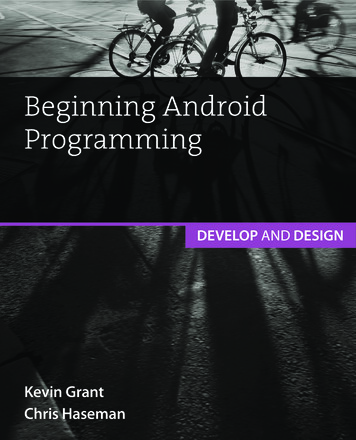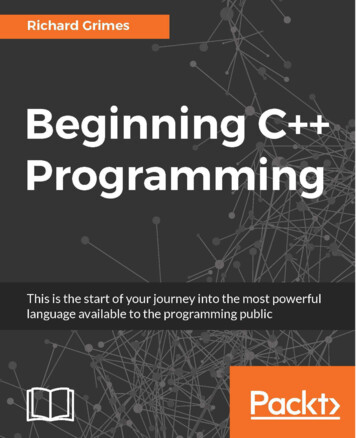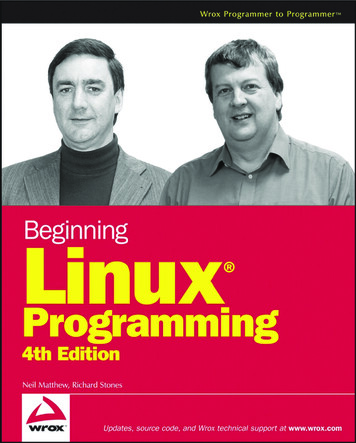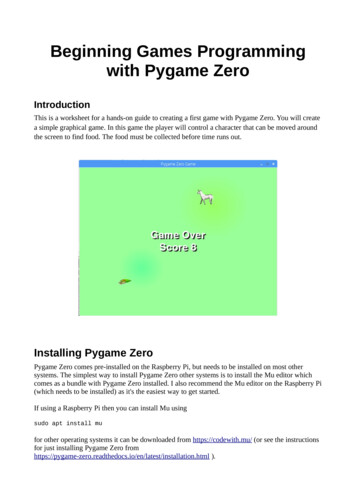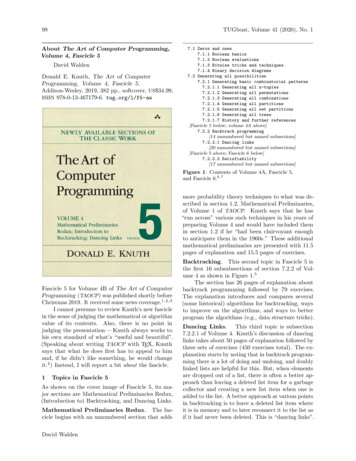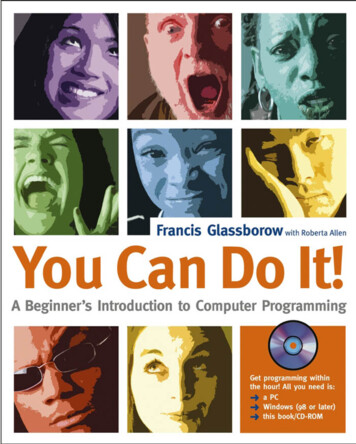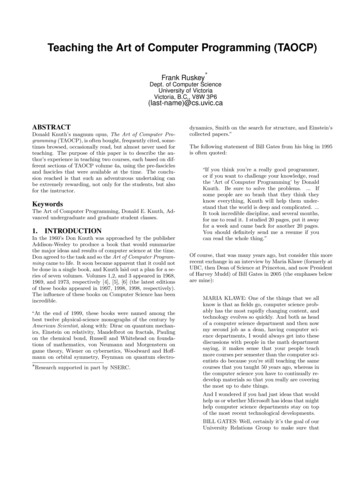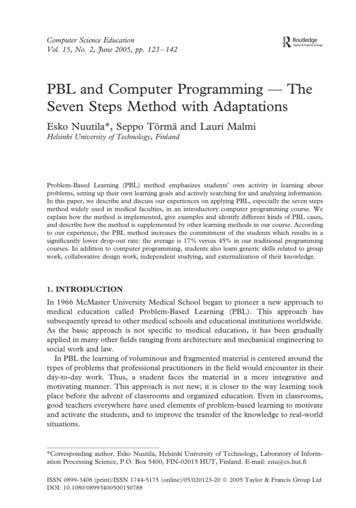
Transcription
Primo ToysBeginning computer programmingfor kids:Beginning computerprogrammingfor kidsAn introductory guide tocomputational thinking and codingfor kids aged 3-6 years old.Anguideto inkingfor kids aged 3-6kids, andandthe codingbest programmingyearsold. for kids.languagesPlus programming ideas for kids, andthe best programming languages forkids.www.primotoys.com
Table of ContentsHello3Why a book and why now?5Who is this book for?6How does this book work?7Who will find each secion most useful?8Part One9What do we mean by introducing computer programming for kids?10Why should kids learn coding and computational thinking at all?13A brief history of coding education for kids19Part Two23The use of age groups in the eBook24Section i) Three to Four Years Old25Section ii) Five to Six Years Old57Part Three73What Next?74Glossary80Bibligraphy83
HelloHello, we are Primo Toys. We’re a team of technologists, designersand educators who make toys that help children learn with technology.You may already know our first toy, Cubetto – a playful wooden robotthat helps young children aged 3 learn the basics of computerprogramming through hands-on play, without a screen.We started building it back in 2013, and we made a bit of a splash last yearwhen we launched Cubetto 2.0 on the crowdfunding platform Kickstarter.We raised 1.6m, becoming Kickstarter’s most-funded educationaltechnology project ever. At the time there were just five of us in the team.Now we are 17 and, after another Kickstarter campaign we look like this:www.primotoys.com3
We created Cubetto because, like an increasing number of academicsand experts, we believe that coding for kids is a new kind of literacyfor the 21st century. We think that for girls and boys, all over the world, learning toprogram will be as important as their ABCs and 123sw in helpingthem understand the world around them. We believe thatintroducing children to a world of algorithms, bugs and queues alsodevelops their problem-solving skills, encourages collaboration andnurtures children’s creativity.Like Maria Montessori, the Italian educationalist acclaimed for hermethod that builds on the way children naturally learn, we thinkthat children learn best through play. We also know that they’remotivated by challenges; and that at very young ages, abstraction(the ability to think about a solution to a problem without trying itout first), is difficult.Coding is a new kindof literacy for the 21stcentury.www.primotoys.com44
Our aim is to help create a new global standard for coding educationthat incorporates this and other approaches to the way children learnbest, both at home and in the classroom. We want to help a newgeneration to realise their full creative potential in a world of rapidlyincreasing technological progress. This ebook is part of that mission.Why a book and why now?In the four years since we started, learning software programmingfor kids – once a niche and nerdy enterprise – has elbowed its waypolitely into the mainstream. Well-publicised and well-fundedprivate and public campaigns (often helped along by very wellknown entrepreneurs and stars – Mark Zuckerberg, Bill Gates,will.i.am ) have helped make this possible. A growing number ofinnovative designers, researchers, and – of course – crowdfundingplatforms, have also helped propel coding toys and programminggames to new heights. Children as young as three or four can nowuse block-based, tangible coding languages like our own or Kibo orGoogle’s Project Bloks; while older children can build and programtheir own robot kits including Lego Mindstorms and LittleBits. Andthen there’s a growing number of programming languages for kids,like MIT’s ScratchJr designed for five to seven-year-olds.Meanwhile, in some countries including the UK, programming isalready part of the curriculum, and there are a huge number of schoolsthat teach coding around the world. So there’s never been moreinformation for parents and teachers dedicated to helping to get kidscoding. If you Google ‘kids’ coding ebook’ you’ll find plenty of engagingpublications that offer a step-by-step initiation to a variety of codinglanguages, all aimed at beginning computer programming for kids.www.primotoys.com5
The problem is that many of these have been written to complementformal schooling, which typically starts in most countries around agesfive or six, and have been written for teachers rather than parents. Sowe decided to produce something that could also help children agedthree to six. An introductory guide that brings together all those vitalhands-on learning techniques and imaginative tips and tricks we’velearned and developed over the years.Who is this book for?This book is primarily for parents who are keen to find out moreabout what computer programming is, and how they can introduceeasy programming for kids in a fun and engaging way.We also hope that teachers, particularly those less familiar withcoding and its key concepts,will find it useful both as an introductionand a tool for their lessons.6
How does this book work?In Part One:‘Introducing coding for kids’, we dip into some of the key terminologythat we’ll use throughout the book that typically causes confusion.We’ll also ask: ‘Why learn to code in the first place?’In addition, there’s a brief but important history of educationalcoding, which introduces some of the bright minds and stunninginnovations that got us to where we are today – it sets the scene forthe rest of the book, so please don’t skip it!In Part Two:We look at two different age groups:Section i. Three to four years old.Section ii. Five to six years old.For both age groups we investigate: How children learn. Which computational and programming concepts should beintroduced at each age. What games and exercises (some that use technology, and othersthat don’t) we can use to teach these concepts in fun, authentic andcreative ways, as well as programming ideas for kids, and the bestprogramming languages for kids.www.primotoys.com7
In Part Three:‘What next?’, we take a quick look at the options available to parentsand educators who want to introduce their children to programmingbeyond tangible devices.Who will find each section most useful?While we hope that you’ll find each part of this book helpful, PartTwo, Section i, on three- to four-year-olds has been written especiallywith parents in mind. Part Two, Section ii, for five- to six-year-olds hasbeen written with both parents and teachers in mind.We hope you enjoy using this book as much as we enjoyed writing it.8
Part OneWhat do we mean by introducingcomputer programming for kids?Why should kids learn coding andcomputational thinking at all?A brief history of coding educationfor kids9
What do we mean by: ‘IntroducingComputer Programming for Kids?’Computing terminology can be tricky. ‘Coding’, ‘programming’,‘computational thinking’ and ‘computer science’ are often usedinterchangeably to mean the same thing. To avoid confusion, let’sstart out by getting them straight.Computer science is the study of what computers can actually do –it’s essentially the theory side of things. Computer scientists test andstudy what is possible using hardware (the physical components ofa computer, like the hard drive and motherboard), and software (theprograms and data that run on and that live in a computer’s hardware).Examples, given by Oxford University, of the kinds of things thatconcern computer scientists include whether computers can help usto model and investigate hugely complex systems like the human body,financial systems or the Earth’s climate.Computational thinking is the thinking tool that computer scientistsuse for the kinds of investigations given above.The BBC puts it most succinctly: Computational thinking ‘allowsus to take a complex problem, understand what the problem is anddevelop possible solutions. We can then present these solutions ina way that a computer, a human, or both, can understand.’Computer programming, on the other hand, is the practice ofmaking a computer do things, normally through lines of code thathave been written to create an intended outcome: ‘If I write ABC thecomputer will do XYZ.’www.primotoys.com10
iStock/RichVintageCoding, even though it’s often used as a catch-all for all three termsabove, is just another slightly more contemporary way of saying‘computer programming’: ie the act of writing code, normally ona screen, to make a computer do something you want it to do.In this book, for reasons we’ll outline later, we’ll focus predominantlyon introducing computational thinking approaches to children inyounger age groups (three to four and five to six), tying in some ofthe basic elements of programming.For a glossary of all the terms we use in the book, please skip to theback!www.primotoys.com11
Why should kids learn codingand computational thinking?1) Coding nurturescreative expression / 2) Programmingdemystifies tech3) It teaches problemsolving and persistence4) Children learn bythinking about doing5) But children also learnto think about thinkingwww.primotoys.com12
Why should kids learn coding andcomputational thinking at all?There’s a common assumption, not always helped by the techindustry itself, that kids need to learn coding because we needmore computer scientists. More software engineers, the argumentgoes, would help shape our digital world for the better and, youknow, it wouldn’t be so bad for the economy either. (The term‘workforce-ready’ comes to mind).To which the obvious response for a parent or educator is: ‘But whatif my child or student doesn’t want to be a computer scientist?’While it’s true that the big tech firms – Google, Facebook, Apple,Tesla – are snapping up whizzkid engineers, there are far moreexciting and compelling arguments for why children should learn tocode, beyond: ‘Because it’s great for GDP.’ Here are five of them:1. Coding nurtures creative expressionCoding for kids is a fundamentally creative process. Just likepainting or cooking, with coding a child benefits from the satisfaction– even the exhilaration – that comes from starting with nothing andfinishing with something.And it goes further. In the real world, creative acts are often limitedby the materials we have at our disposal – like ingredients when wecook, or the canvas when we paint. But with programming, where thevirtual world is infinite, the only restriction is the child’s imagination.www.primotoys.com13
Coding for kids is afundamentally creativeprocess; starting withnothing and finishingwith something.www.primotoys.com14 iStock/romrodinka
2. Programming demystifies techThe University of Oxford forecasts that in the next 20 years as manyas 47 per cent of jobs in the United States will become completelyautomated. Meanwhile, predictions on the number of connecteddevices that will be in use by 2020 as part of the Internet of Things varyfrom 20 billion to 75 billion.Because of this proliferation of devices and computers, there’s agrowing anxiety about the increasing role of artificial intelligenceand computers, in particular whether machines will make workersobsolete. Understanding what computers can and can’t do isfundamental in addressing these anxieties. If we can teach childrenhow to remodel the technological world around them, we can helpthem become creators rather than just consumers of technology.www.primotoys.com15 iStock/weerapatkiatdumrong
In the next 20 yearsas many as 47% ofjobs in the USA willbecome completelyautomated.www.primotoys.com16
3. Teaching kids programming requirespersistence and problem-solvingAnyone who’s played with code, from beginners to professionals, will tellyou that writing programs can get quite challenging quite quickly. Orput more simply: coding can be frustrating. Really, really frustrating.This, says computer scientist and educator Sheena Vaidyanathan, isunreservedly a good thing: children ‘learn that something doesn’t workout but you can quickly fix it and try it again in different ways.’With an introduction to programming, children learn to think laterallywhen faced with a problem in coding: ‘If A B didn’t work, thenmaybe A C will.’ Coding also equips kids with the ability to stick witha problem and work on finding a solution.4. Children learn by thinking about doingThe grandfather of coding education, Seymour Papert (more on him inbit), was a huge advocate of teaching by using programmable robotsfor kids. He was also a huge advocate of the principle that we learn bydoing. As he saw it, the two worked hand in hand: ‘Programming therobot to do something helps a child to think about “doing”.’However, to this he added an interesting qualification: ‘You learn bydoing but you learn better by thinking about what you are doing. Ithink this is what is most important.’In essence, thinking about what you want to do, one step at a time,before you do it, enhances the learning process.www.primotoys.com17
With programming,children learn to thinklaterally when facedwith a problem.5. But children also learn to thinkabout thinkingPapert (him again) also spoke of the discovery and the senseof wonder that children experience when first introduced toprogramming. ‘In teaching the computer how to think, childrenembark on an exploration about how they themselves think. Theexperience can be heady: Thinking about thinking turns the child intoan epistemologist, an experience not even shared by most adults.’For us, this is the argument that is the most exciting. More thananything, computational thinking is an unbelievably valuable thinkingtool – perhaps the thinking tool of the 21st century – and one that canbe applied throughout our lives to incredible effect.www.primotoys.com18
A very brief history of codingeducation for kidsCoding education as we know it today started 60 years ago with aturtle and a four-letter word that sounds like, but definitely is
that helps young children aged 3 learn the basics of computer programming through hands-on play, without a screen. We started building it back in 2013, and we made a bit of a splash last year when we launched Cubetto 2.0 on the crowdfunding platform Kickstarter. We raised 1.6m, becoming Kickstarter’s most-funded educational technology project ever. At the time there were just five of us in .
